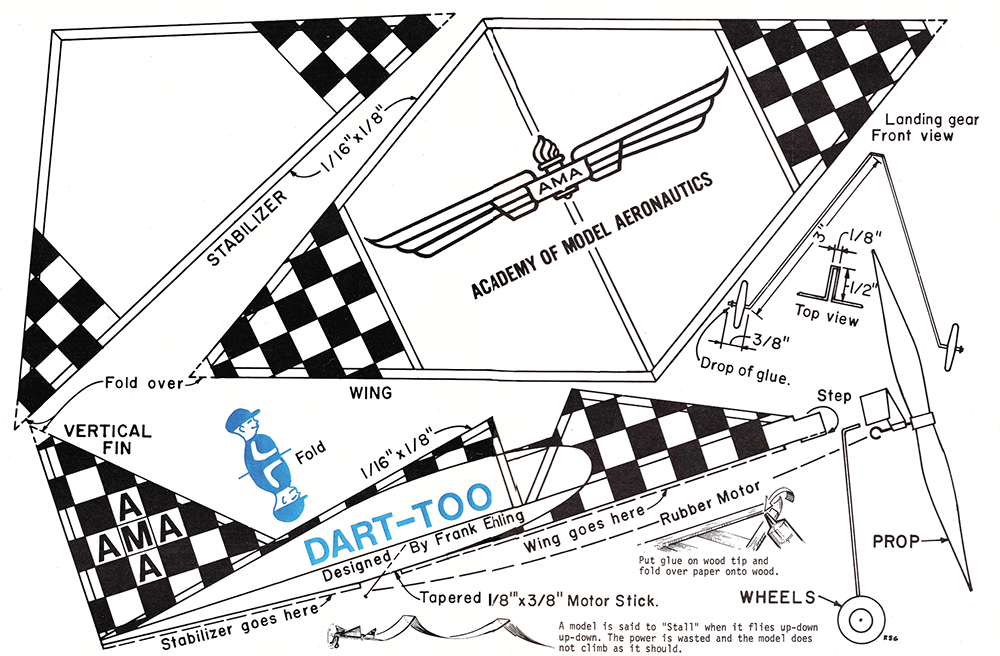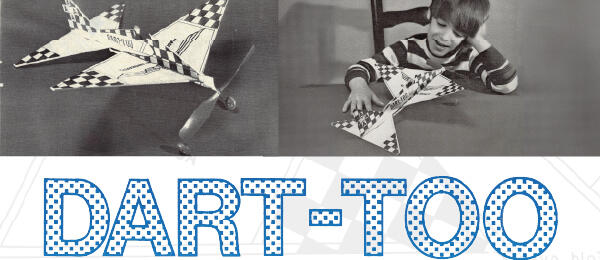
DOWNLOAD FREE PLANS!
THE DART-TOO is an AMA project conceived (like its predecessor, the Delta Dart, also known as the AMA Cub) by Frank Ehling, Technical Director of the Academy of Model Aeronautics, in his "off-duty" hours. Frank donated this design (as he did the Delta Dart) to Model Aviation as a tool to be used, as a second step, in developing the beginner’s aero-modeling skill.
The Dart-Too uses the AMA Cub wing and tail and was designed as a follow-up to the AMA Cub. It provides an additional feeling of accomplishment for the builder because of the fuselage profile, which more nearly resembles a full-scale aircraft than it does the basic AMA Cub. It allows the beginner to produce a second model that can be built in approximately the same time (about one hour) as the AMA Cub and further develops his ability to work with his hands. This is much preferred to stepping up to a too-complicated model if the result is only to drop it before completion.
Some may feel that the Dart-Too is not sufficiently advanced from the AMA Cub. Not so! It has been found that by building one, two, three or more AMA Cubs, each model advances in workmanship as the young modeler’s skill and dexterity progresses. His understanding also increases with each model completed. Like the AMA Cub, Dart-Too can be used in the classroom for teaching the fundamentals of aerodynamics, geometry and mathematics, while also providing student satisfaction in carrying a project through to completion—and to the pleasure of flight!

Notes on Construction
All structure is 1/16 × 1/8-inch balsa except the motor stick, which is cut from 1/8 × 3/8 inch balsa. For simplicity, the plan as it appears here can be used as a covering material by simply removing two pages from the magazine and taping them together (underneath), then gluing the appropriate wood sizes directly to the page within the outlines indicated. Don’t worry about the weight of the paper—it’s light enough. White glue diluted 50% with water works well, but dilute glue only for covering—use full strength (undiluted) for balsa-to-balsa joints. Very little glue is needed to adhere the framework to the covering and excess should be wiped away before attaching the balsa wood strips to the covering. The wing and stabilizer covering will be on the bottom in this case, which creates no problem.


The vertical fin is made right along with the fuselage. Here, as with the other surfaces, only one side is covered for lightness.
Pay special attention to the nose of the fuselage where the propeller thrust bearing is positioned. Cut off a 1/16-inch slice from the top as shown, and glue it directly below to make a "step" as the plan indicates. This is done so that the rubber motor will clear the wing. A pin inserted aft of the wing serves as a rear hook (anchor) for the rubber motor.
After the wing has been completed, but before being bent to provide the dihedral, glue the wing to the bottom of the motor stick. Place Delta-Too upside down on the building board or workbench, resting on the vertical fin and fuselage nose, then pin the wingtips down to the board or bench to provide the proper amount of dihedral.
Although the landing gear is not necessary, an ROG (Rise-Off-Ground) provides a change from your normal hand launch and offers a more realistic flight pattern. The landing gear may be bent from .032 music wire, with small wheels cut from balsa or "cannibalized" from any small model. Or, you may use landing gear from a North Pacific Skeeter or similar ready-to-fly model.
An AMA Cub propeller assembly from Sig Manufacturing Co., 401 S. Front St., Montezuma, Iowa 50171, is perfect for the Dart-Too, as is the prop assembly from the ready-to-fly North Pacific Skeeter (available from many hobby shops, supermarkets, drug stores, etc.).
AMA Cub (Delta Dart) flight instructions can be used in getting the Dart-Too to perform in the air. If the model shows any tendency to stall under power (see sketch), simply bend the thin part of the plastic propeller assembly (underneath) to the right when looking down from above with the model facing away from you. This will cause the model to fly in circles rather than stall. It cannot stall if it’s circling. If it stalls in the glide, correct by adding a smallamount of clay to the nose directly over the thrust bearing.
A lighter covering than the magazine page can improve flight characteristics. This may be achieved by covering the magazine plan with plastic wrap, followed by your choice of lightweight covering (tissue, onionskin, etc.) and building the Delta-Too on this. Or you may trace the plan on your lightweight covering and turn it over for building so that Delta-Too’s balsa structure is glued underneath the covering. When completed, the covering will be on top of the flying surfaces. Alternatively, you may use the drawing as a construction plan. The model may then be covered with tissue, offering a first lesson in covering an open structure model.
Use your heaviest balsa in the wing and lighter wood for the stabilizer and vertical fin. The fuselage portion could be of either heavy or lightweight balsa. Stiff paper or cardboard may be sandwiched between the two halves of the "pilot" and cemented into the cockpit. The Dart-Too is a snappy, low-wing "second model," which the beginner will enjoy building and flying. Remember that practice makes perfect and you—or the youngster you’re teaching—may want to build several before tackling more advanced rubber- or fuel-powered craft.










Comments
Add new comment